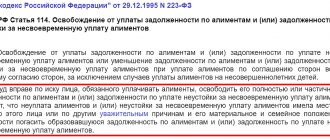By the way: We provide online consultations. Reliable, expert, confidential. More details
By the way: We can collect the maximum alimony More details
Dissolution of a marriage is especially difficult if the couple has minor children. The first place among all kinds of problems is occupied by the issue of further maintenance of children, which requires a competent solution in order to avoid infringement of their rights. A legal structure, the purpose of which is to ensure a decent standard of living for children after the separation of parents, is called alimony obligations; this is a property obligation for the maintenance of a child by another parent living separately.
Entrepreneurship is currently one of the most popular areas of activity, therefore, the peculiarities of the position of an individual entrepreneur as an alimony payer are particularly relevant. Most citizens are not aware of how alimony is collected from individual entrepreneurs, in what amount and how it is written off.
How does an individual entrepreneur pay child support?
Like other persons whose income is fixed, an individual entrepreneur is obliged to fully fulfill the responsibilities of supporting his child. However, if in the first case the employer is responsible for the correct transfer of funds, then the entrepreneur himself is responsible for fulfilling obligations in the proper amount and time frame. In this regard, the problem arises of determining the exact figure for payment of alimony for a minor, since the law does not directly establish what should be recognized as income of an entrepreneur. An accurate determination of the amounts is extremely important, otherwise there is a risk of debt formation, which may result in the collection of a penalty, foreclosure by bailiffs on property and other sanctions, which only become more stringent every year.
The legislation provides for the following methods of collecting alimony:
Payments by agreement of the parties
Making child support payments by mutual agreement is the most convenient option for both parents. This fact will help avoid legal disputes. Among other things, the document can determine that the payment of alimony can be replaced, for example, by a gift of real estate to the child, or it can be determined that monthly payments will be set in an amount greater than that specified in the law.
The agreement can define mutually beneficial conditions.
The agreement is drawn up at a notary’s office, and the following documents should be provided here:
- parents' passports;
- children's birth certificates;
- document confirming income.
The cost of notarization of a document will be 5,250 rubles.
If the alimony payer subsequently violates the terms of the agreement, then the alimony recipient with this agreement has the right to turn to the bailiffs for help in collecting the amounts.
Important! The alimony agreement has the force of a writ of execution issued by the court.
By setting a fixed amount
This method is appropriate in situations where the parent has an irregular income or its amounts vary greatly at different periods of time. A specific payment figure is fixed, regardless of the debtor’s income; even if it was zero, he will be required to make deductions. This method is the simplest and does not cause unnecessary controversy. A specific fixed amount can be determined both in an agreement and by a court; if necessary, it can be increased through legal proceedings.
What documents are needed for collection?
If an unscrupulous parent refuses to provide assistance in supporting his child, then he should contact the court.
The following must be attached to the claim:
- Duplicate passport.
- Duplicates of children's birth certificates.
- Duplicates of documents on the conclusion and dissolution of a marriage union.
- Papers about the family composition of the plaintiff and the unscrupulous alimony provider, if such a possibility exists.
In addition to the listed documents, the applicant may attach to the claim other papers that he considers necessary for the case.
Additional evidence may include:
- documents on the amount of income of the parties;
- papers confirming the applicant’s expenses for the child;
- and so on.
The court makes a decision on the payments that the alimony will transfer.
Payments may also be enforced by the bailiff service if the parent refuses to pay the amounts.
Determining the amount of maintenance as a share of the income received
The method is used if there is information about the monthly stable income of the entrepreneur. However, it is worth considering that entrepreneurial activity is primarily associated with risks, and income is sometimes simply unpredictable. It is a difficult task to correctly determine a person’s income taking into account a specific taxation system, which will become the basis for calculating alimony.
Revenue share
NOTE!
Some entrepreneurs prefer to use a combined approach to calculating alimony, that is, one part of the obligation is determined by the first method (fixed amount), the other by the second (percentage of income), which allows them to adequately plan their expenses. This method is completely acceptable and legal.If you have a similar situation and are looking for a way to solve it, then feel free to dial our number + right now. Our experienced lawyers will answer difficult questions and take control of any complex case.
Size
The amount of the share of income that will be used to pay alimony depends on the number of persons supported:
- 25% is charged per child;
- 33% - for 2 children;
- 50% - for 3 or more children (in some cases this figure can reach up to 70%).
If the payment is replaced by a fixed one, then the amount will be calculated based on the defendant’s income and the regional subsistence level for the person for whose maintenance the money will be used. Eg:
- healthy child or disabled children;
- disabled adult;
- pregnant woman, etc.
Important!
When concluding a mutual agreement between the parties, other terms and amounts of payments may be specified. For example, it is allowed to make payments not every month, but at other time intervals, increasing their amount. Payments are indexed by an average of 3-10%. The payment is reviewed either by an accountant or by bailiffs.
How much is alimony calculated from?
For a long time, alimony was calculated and collected from income as a whole, without taking into account expenses, which can be quite significant or even exceed income at some point in time. This state of affairs did not suit the individual entrepreneurs, which is why one of them was able to get the Constitutional Court to recognize the need to take into account expenses when calculating amounts, but only if they were confirmed.
The judges recognized the need to find out the real income of the ex-spouse, because it is precisely this that is an adequate reflection of the financial situation of the entrepreneur.
Currently, the basis for calculating alimony is net income from business, that is, deprived of expenses incurred in the course of business and tax deductions applicable in the corresponding taxation system. It is the amount from which the tax is calculated and deducted that is the basis for making calculations for alimony.
IMPORTANT
: Alimony amounts are not included in a businessman’s expenses, since they arise specifically in the sphere of family relations and have no connection with business activities.
Thus, only after the income is received, the entrepreneur can allocate the appropriate percentage, which is the amount of alimony. Both income and expenses must be documented, and the individual entrepreneur has the responsibility to prove the validity of expenses. The bailiff collecting alimony from an individual entrepreneur is obliged to check the correctness of the calculation of alimony, if necessary, sending requests to the tax service.
How to calculate
In accordance with Article 83 of the Family Code, alimony payments can be calculated in a fixed amount. This is calculated proportionally in relation to the cost of living.
If the income of an individual entrepreneur is more or less constant and an adequate amount of payments can be paid regularly, alimony can be calculated as a percentage of income.
In this case, the calculation is carried out on the basis of Article 81 of the RF IC:
| per child | 25% of income |
| for two children | 33,33% |
| if you have three or more children | 50% |
It is important to take into account that for a pregnant spouse or raising a child under three years of age, as well as for disabled adult children, alimony can only be paid in a fixed amount.
When calculating alimony payments as a percentage of income, the question becomes relevant: “What amount should payments be calculated from - from the individual entrepreneur’s income or from profit?” The situation was resolved legislatively only in 2013 through the adoption of an act on the procedure for collecting alimony from individual entrepreneurs.
This document determines that alimony should be collected from the businessman’s net profit. To determine this, production costs and tax payments are subtracted from the entrepreneur’s income. The remaining amount is considered net profit.
The law also determines that alimony cannot be classified as an expense item for an individual entrepreneur. These payments are not related to entrepreneurship, being family and personal financial obligations.
Compulsory alimony may be collected from individual entrepreneurs if:
- assistance to a minor or disabled adult child is not provided on a voluntary basis;
- the entrepreneur refuses to support a pregnant spouse or a wife with a small child under three years of age. It does not matter whether the spouse is present or former;
- there is a refusal to provide financial support to a disabled minor child or a child with the first group of disabilities since childhood.
Payment of alimony by an individual entrepreneur is carried out according to the terms specified in the writ of execution or alimony agreement.
As a rule, payments are made monthly. But combined payment is not prohibited, when half of the alimony amount is paid once a month, and the rest - once a quarter. The procedure for payments depends entirely on the agreement of the parties and the conditions specified in the writ of execution.
Article 117 of the Insurance Code provides for indexation of alimony for fixed payments. That is, when the cost of living changes, the amount of alimony is also revised.
If alimony is paid by mutual agreement, then the parties independently decide on the need for indexation.
Direct payments are made by depositing the required amount into the recipient's bank account. An individual entrepreneur can also transfer payments by bank transfer from his account.
Alimony from individual entrepreneurs on a simplified basis (USN)
Simplified alimony (USN) is established depending on the accounting of expenses.
- If the simplified tax system “income minus expenses” is used, alimony is calculated from the resulting amount of profit. To confirm the calculation made, the entrepreneur must provide a book of income and expenses, the maintenance of which is mandatory.
- If an individual entrepreneur uses a simplified “income” system, then it becomes difficult to establish the exact amounts of expenses. In this case, the entrepreneur should keep a book of income and expenses, although the legislator under this tax regime does not oblige him to do this, or collect documents on expenses incurred. Otherwise, collection will be made entirely from income.
Agreement on payment of alimony
If an individual entrepreneur agrees to a voluntary payment, the law provides for such a possibility. To do this, the parents enter into an agreement between themselves, in which they indicate all the important points regarding payments for the maintenance of the second spouse or child. Such a document must be certified by a notary.
The agreement pays attention to the following main points:
- indicate the full name of the payer and recipient; if we are talking about child support, enter the dates of their birth;
- determine the date from which the individual entrepreneur pays the amount of money, because it is from this that the calculation of income begins;
- the amount of alimony and the procedure for its payment are established; please note: the amount cannot be less than that collected in court;
- The most convenient option for entrepreneurs is a combined payment scheme: part of the alimony amount is fixed, the rest is calculated depending on income. This approach makes it possible to determine a certain minimum of alimony payments and will protect against further litigation regarding the revision of the amount of alimony that was established in the agreement;
- procedure and methods of payment of maintenance. By default, it is assumed that the entrepreneur pays alimony every month, but the law does not prohibit establishing other frequency, including a combined one: a fixed amount - every month, a variable amount - at the end of the quarter. It must be taken into account that if there is no indication of frequency, maintenance payments must be made every month;
- It is definitely worth considering the issue of indexation - the amount of alimony can be revised depending on inflation and changes in the level of income of the payer; if this question is not clarified, indexation is carried out in the general manner, that is, the amount of alimony is recalculated and increased simultaneously with the increase in the level of the cost of living in the region or in the country as a whole.
Additionally, the agreement should describe the procedure for the parties to act in such situations:
- late payments - it can be punished by penalties or fines, seizure of the entrepreneur’s property;
- termination of the agreement - unless this point is separately considered, the default is that the agreement expires when the children reach the age of 18 or upon the death of one of the parties. If the agreement is concluded for a shorter period, this should definitely be indicated in the document.
Alimony from individual entrepreneurs to UTII and the patent tax system
Entrepreneurs subject to the single tax on imputed income (UTII) must submit a UTII declaration as proof of income. But in such a declaration only the subject’s imputed income is recorded, and not the real one. This position itself contradicts the previously stated statement of the Ministry of Finance about the impossibility of using imputed income as the base amount for calculating alimony. But how to identify real income when an individual entrepreneur is not even obliged to keep accounting records, being on UTII?!
Thus, the issue of how individual entrepreneurs pay alimony with UTII has not yet been finally resolved. In the above situation, bailiff services often calculate alimony not from real income, but from conditional, imputed income, from which taxes are calculated. That is why it is best to oblige entrepreneurs on UTII to pay alimony in a fixed amount, since imputed income in some cases may be insufficient to fully pay alimony.
A similar situation exists with the patent taxation system.
Alimony for individual entrepreneurs with zero income
A frequent case is when the debtor is registered as an individual entrepreneur, but does not actually work and has no official income.
My business is not working, there is nothing to pay...
In this situation, the calculation of alimony should be made based on the average earnings of a citizen of the Russian Federation in the current year. Official statistics on this topic can be found on the Rosstat website. Thus, the average salary in the Russian Federation is at the level of 36,709 rubles, in Moscow - 92,389 rubles, in the Moscow region - 42,656 rubles.
There is only one conclusion here - without qualified legal assistance, it is problematic to resolve the issue of collecting alimony from an individual entrepreneur. Specialists of the MCPI “Planet of Law” within the framework of turnkey legal assistance under the “Alimony? “Elementary!” will provide you with exclusively professional assistance in collecting alimony from individual entrepreneurs. Call now + 7.
Collection of alimony from an individual entrepreneur
Payment of alimony by agreement of the parties
When parents agree among themselves on the amount of monthly payments for child support, they must enter into a “Agreement on Payment of Child Support.” With the help of this agreement, the court, in case of problems with the payment of alimony, can recover from the payer parent who entered into this agreement, in which he undertakes to pay a certain amount for the maintenance of the child.
Such an agreement must be notarized in order to have legal force. The contents of the agreement must include: name, date and place of conclusion, personal data of each party, as well as their common children, type and amount of payments, procedure for transferring funds, conditions for possible termination of the application, signatures. Also, in the content of the agreement, when paying a fixed amount, there must be a clause on indexation of the monetary amount.
How to collect alimony from an individual entrepreneur
To collect alimony from an individual entrepreneur, you must file a claim with the court at your place of residence. In cases where a percentage can be calculated from an individual entrepreneur’s income for payments, you can file a claim with the magistrate’s court and within five days the court will issue an order. If, when collecting alimony, a fixed monetary amount system is used, the claim must be filed with the district court, where the trial will take place, and within a week the court will make a decision and issue a writ of execution.
Note!
Having in hand an order from the magistrate's court or a writ of execution from the district court, the plaintiff needs to contact the bailiffs, who will open the enforcement case.
You need to go to court with the following documents prepared:
- Passports and copies of passports of the plaintiff and defendant, if the latter appears in court.
- Certificate and copy of the child’s birth certificate.
- Certificate of marriage or divorce.
- Certificate of family composition.
- Under certain conditions, a certificate from social authorities confirming preferential status.
- Documents reflecting the financial condition of the defendant.







